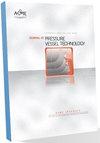Fluid End Blocks: Numerical Analysis of Autofrettage and Reautofrettage Based Upon A True Material Model
IF 1.4
4区 工程技术
Q4 ENGINEERING, MECHANICAL
Journal of Pressure Vessel Technology-Transactions of the Asme
Pub Date : 2023-01-05
DOI:10.1115/1.4056605
引用次数: 0
Abstract
Fluid end blocks (FEBs) are the most important components of hydraulic fracturing pumps. A potential important application of the hydraulic autofrettage process (HAP) is to strengthen the fatigue-prone FEBs. This creates a favorable compressive residual stress field near to the critical surface locations within the component and serves to increase its pressure-bearing capacity and/or improve lifetime. This requires a fundamental understanding and modeling of the complex mechanics of the HAP in order to accurately predict such residual stresses. The key outstanding modeling issue is the complex material behavior, dominated by the Bauschinger effect and associated with reversed yielding. This effect differs throughout the FEB. It has been modeled for plane axisymmetric cylinders but has not previously been incorporated into FEB analyses. In this paper, a newly developed finite element analysis (FEA)-based user programmable function (UPF), featuring true material constitutive behavior, i.e., replicating an existing Bauschinger-effect characterization (BEC), is adopted to accurately simulate the HAP and quantitatively investigate the stress-strain evolution and residual stress fields throughout the FEB. This simulation is then compared with FEA modeling by a traditional bilinear kinematic hardening material model to indicate the importance of the accuracy of the material constitutive model in determining appropriate residual stresses and strains. An autofrettage pressure of 500MPa generally achieves net compressive hoop stresses at each of four critical crossbore location. Finally, a prospective re-autofrettage sequence is described; approximate modeling suggests an improvement that might permit operation at higher working pressure.流体端块:基于真实材料模型的自增强和再自增强数值分析
流体端块(feb)是水力压裂泵的重要部件。水力自强化工艺(HAP)的一个潜在的重要应用是加强易疲劳的feb。这在部件内的关键表面位置附近创造了有利的压残余应力场,有助于增加其承压能力和/或延长使用寿命。这需要对HAP的复杂力学有一个基本的理解和建模,以便准确地预测这种残余应力。关键突出的建模问题是复杂的材料行为,由鲍辛格效应主导,并与反向屈服相关。这种效应在整个2月都有所不同。它已经被模拟为平面轴对称圆柱体,但以前没有被纳入FEB分析。在本文中,新开发的基于有限元分析(FEA)的用户可编程函数(UPF),具有真实的材料本构行为,即复制现有的包辛格效应表征(BEC),并将模拟结果与传统双线性运动硬化材料模型的有限元模拟结果进行了比较,说明了材料本构模型的准确性对于确定合适的残余应力和应变的重要性。自增强压力为500MPa时,在四个临界井眼位置均可获得净压环向应力。最后,描述了一个有前景的再自增强序列;近似模拟表明,可以在更高的工作压力下进行改进。
本文章由计算机程序翻译,如有差异,请以英文原文为准。
求助全文
约1分钟内获得全文
求助全文
来源期刊
CiteScore
2.10
自引率
10.00%
发文量
77
审稿时长
4.2 months
期刊介绍:
The Journal of Pressure Vessel Technology is the premier publication for the highest-quality research and interpretive reports on the design, analysis, materials, fabrication, construction, inspection, operation, and failure prevention of pressure vessels, piping, pipelines, power and heating boilers, heat exchangers, reaction vessels, pumps, valves, and other pressure and temperature-bearing components, as well as the nondestructive evaluation of critical components in mechanical engineering applications. Not only does the Journal cover all topics dealing with the design and analysis of pressure vessels, piping, and components, but it also contains discussions of their related codes and standards.
Applicable pressure technology areas of interest include: Dynamic and seismic analysis; Equipment qualification; Fabrication; Welding processes and integrity; Operation of vessels and piping; Fatigue and fracture prediction; Finite and boundary element methods; Fluid-structure interaction; High pressure engineering; Elevated temperature analysis and design; Inelastic analysis; Life extension; Lifeline earthquake engineering; PVP materials and their property databases; NDE; safety and reliability; Verification and qualification of software.

 求助内容:
求助内容: 应助结果提醒方式:
应助结果提醒方式:


